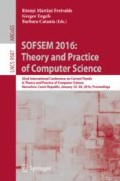Abstract
The Essence standard combines a kernel and a modelling language for software engineering. It defines dynamic semantics of Essence by a mixture of formal and informal means. This paper presents a uniform formalization of the dynamic semantics based on a graph grammar and discusses various applications of this grammar. It is shown that solid formal foundation is useful for research towards theory oriented software engineering.
Access this chapter
Tax calculation will be finalised at checkout
Purchases are for personal use only
Notes
References
Software Engineering Metamodel for Development Methodologies (ISO/IEC 24744)
Omg Meta Object Facility (April 2014)
Essence - Kernel and Language for Software Engineering Methods (September 2015)
Bardohl, R., Taentzer, G., Minas, M., Schürr, A.: Application of Graph Transformation to Visual Languages, pp. 105–180. World Scientific, London (1999)
Baresi, L., Heckel, R.: Tutorial introduction to graph transformation: A software engineering perspective. In: Corradini, A., Ehrig, H., Kreowski, H.-J., Rozenberg, G. (eds.) ICGT 2002. LNCS, vol. 2505, pp. 402–429. Springer, Heidelberg (2002)
Blostein, D., Schürr, A.: Computing with graphs and graph transformations. Softw.-Pract. Experience 29(3), 197–217 (1999)
Bottoni, P., Taentzer, G., Schürr, A.: Efficient parsing of visual languages based on critical pair analysis and contextual layered graph transformation. In: 2000 IEEE International Symposium on Visual Languages (VL 2000), pp. 59–60 (2000)
Corradini, A., Montanari, U., Rossi, F., Ehrig, H., Heckel, R., Löwe, M.: Algebraic Approaches to Graph Transformation. Part I: Basic Concepts and Double Pushout Approach, pp. 163–245. World Scientific, London (1997)
Ehrig, H., Löwe, M.: Compugraph. Computing by graph transformation. Final report. Technical report, ESPRIT Basic Research Working Group No. 3299, Berlin (1992)
Elvester, B., Benguria, G., Ilieva, S.: A comparison of the essence 1.0 and SPEM 2.0 specifications for software engineering methods. In: Proceedings of the Third Workshop on Process-Based Approaches for Model-Driven Engineering (PMDE 2013)
Engels, G., Hausmann, J.H., Heckel, R., Sauer, S.: Dynamic meta modeling: a graphical approach to the operational semantics of behavioral diagrams in uml. In: Evans, A., Caskurlu, B., Selic, B. (eds.) UML 2000. LNCS, vol. 1939, pp. 323–337. Springer, Heidelberg (2000)
Henderson-Sellers, B., Gonzalez-Perez, C.: The rationale of powertype-based metamodelling to underpin software development methodologies. In: Proceedings of the 2nd Asia-Pacific Conference on Conceptual Modelling - vol. 43, APCCM 2005, pp. 7–16 (2005)
Holtappels, S.: Eine formale Beschreibung der dynamischen Semantik von ESSENCE. Master’s thesis, Universität Duisburg-Essen (2014)
Jacobson, I., Ng, P.-W., McMahon, P.E., Spence, I., Lidman, S.: The Essence of Software Engineering: Applying the SEMAT Kernel. Addison-Wesley Professional, Reading (2013)
Kuske, S.: A formal semantics of UML state machines based on structured graph transformation. In: Gogolla, M., Kobryn, C. (eds.) UML 2001. LNCS, vol. 2185, pp. 241–256. Springer, Heidelberg (2001)
Maggiolo-Schettini, A., Peron, A.: A graph rewriting framework for Statecharts semantics. In: Cuny, J., Ehrig, H., Engels, G., Rozenberg, G. (eds.) Graph Grammars and Their Application to Computer Science. LNCS, vol. 1073, pp. 107–121. Springer, Heidelberg (1996)
Schwaber, K., Sutherland, J.: The scrum guide. the definitive guide to scrum: the rules of the game (2013)
Software and Systems Process Engineering Metamodel Specification (SPEM) Version 2.0, Document formal/2008-04-01 (April 2008). http://www.omg.org/spec/SPEM/2.0/
Toffetti, G., Pezzè, M.: Graph transformations and software engineering: success stories and lost chances. J. Vis. Lang. Comput. 24(3), 207–217 (2013)
Author information
Authors and Affiliations
Corresponding author
Editor information
Editors and Affiliations
Rights and permissions
Copyright information
© 2016 Springer-Verlag Berlin Heidelberg
About this paper
Cite this paper
Holtappels, S., Striewe, M., Goedicke, M. (2016). From ESSENCE to Theory Oriented Software Engineering. In: Freivalds, R., Engels, G., Catania, B. (eds) SOFSEM 2016: Theory and Practice of Computer Science. SOFSEM 2016. Lecture Notes in Computer Science(), vol 9587. Springer, Berlin, Heidelberg. https://doi.org/10.1007/978-3-662-49192-8_4
Download citation
DOI: https://doi.org/10.1007/978-3-662-49192-8_4
Published:
Publisher Name: Springer, Berlin, Heidelberg
Print ISBN: 978-3-662-49191-1
Online ISBN: 978-3-662-49192-8
eBook Packages: Computer ScienceComputer Science (R0)

